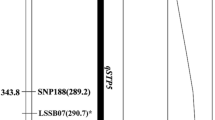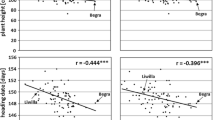Abstract
Lycopersicon peruvianum LA2157 originates from 1650 m above sea level and harbours several beneficial traits for cultivated tomatoes such as cold tolerance, nematode resistance and resistance to bacterial canker (Clavibacter michiganensis ssp. michiganensis). In order to identify quantitative trait loci (QTLs) for bacterial canker resistance, a QTL mapping approach was carried out in an F2 population derived from the interspecific F1 between Lycopersicon esculentum cv Solentos and L. peruvianum LA2157. Three QTLs for resistance mapped to chromosomes 5, 7 and 9 respectively. The resistance loci were additive and co-dominant with the QTL on chromosome 7 explaining the largest part of the variation for resistance in the F2 population. The combination of this QTL with either of the other two QTLs conferred a resistance similar to the level in the resistant parent L. peruvianum. Some RFLP markers flanking this QTL on chromosome 7 were converted into SCAR markers allowing efficient marker-assisted selection of plants with high resistance to bacterial canker.
Similar content being viewed by others
Author information
Authors and Affiliations
Additional information
Received: 26 February 1999 / Accepted: 12 March 1999
Rights and permissions
About this article
Cite this article
van Heusden, A., Koornneef, M., Voorrips, R. et al. Three QTLs from Lycopersicon peruvianum confer a high level of resistance to Clavibactermichiganensis ssp. michiganensis. Theor Appl Genet 99, 1068–1074 (1999). https://doi.org/10.1007/s001220051416
Issue Date:
DOI: https://doi.org/10.1007/s001220051416




